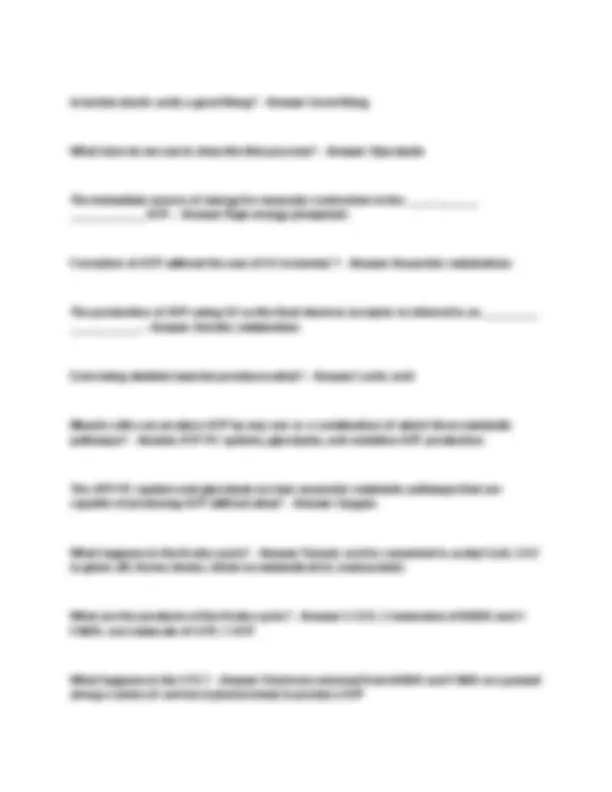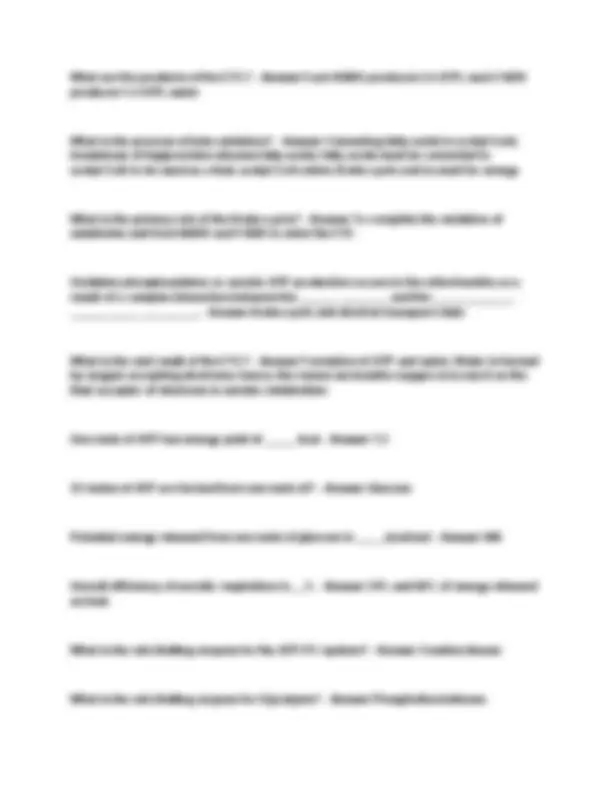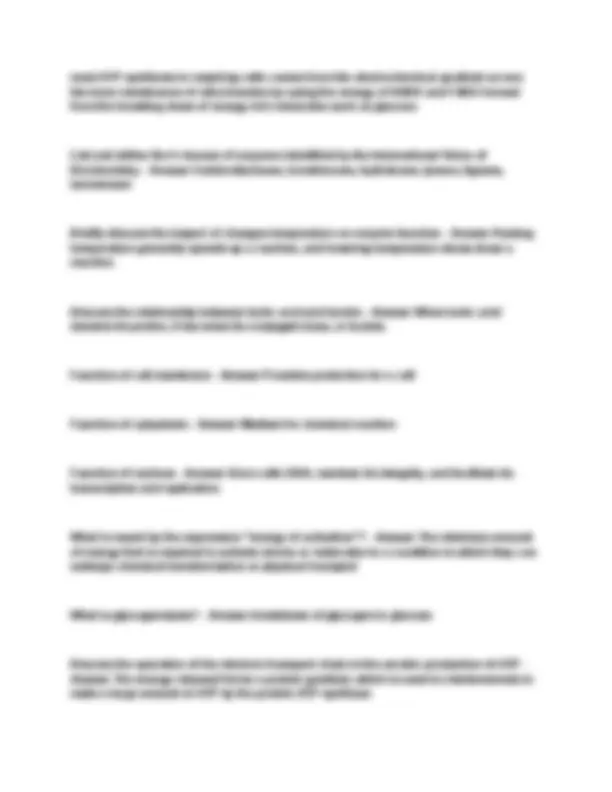







Study with the several resources on Docsity

Earn points by helping other students or get them with a premium plan


Prepare for your exams
Study with the several resources on Docsity

Earn points to download
Earn points by helping other students or get them with a premium plan
Community
Ask the community for help and clear up your study doubts
Discover the best universities in your country according to Docsity users
Free resources
Download our free guides on studying techniques, anxiety management strategies, and thesis advice from Docsity tutors
A comprehensive set of questions and answers covering key concepts in bioenergetics, a crucial area of study in kinesiology. It delves into the processes of energy production within the body, exploring topics such as glycolysis, the krebs cycle, and oxidative phosphorylation. The document also examines the role of enzymes, the impact of temperature on enzyme function, and the relationship between lactic acid and lactate. It is a valuable resource for students seeking to deepen their understanding of bioenergetics and prepare for exams.
Typology: Exams
1 / 9

This page cannot be seen from the preview
Don't miss anything!






What is glycogenolysis? - Answer Biochemical pathway in which glycogen breaks downinto glucose-1-phosphate and glucose
Why are only 2 ATPs produced during glycolysis? - Answer What is metabolism? - Answer Sum of all chemical reactions that occur in the body Anabolic reactions - Answer Synthesis of molecules Catabolic reactions - Answer Breakdown of molecules What is bioenergetics? - Answer Converting foodstuffs into energy; formation of ATP What are coupled reactions? - Answer The energy given off by the exergonic reactionpowers the endergonic reaction
What is oxidation? - Answer Removing an electron What is reduction? - Answer Addition of an electron Oxidation and reduction are always _________ ___________. - Answer Coupled reactions Oxidation-reduction reactions often involves the _________ ___ __________ atoms ratherthan free electrons. - Answer Transfer of hydrogen
What are the factors that alter enzyme activity? - Answer Temperature and ph How does temperature affect enzyme activity? - Answer Small rise in body tempincreases enzyme activity; exercise results in increased body temp
How does pH affect enzyme activity? - Answer Changes in pH reduces enzyme activity;lactic acid produced during exercise
What is the importance of an oxidation-reduction reaction? - Answer Provide cellularenergy, because the flow of electrons between molecules produces useable energy
Fatty acids - Answer Primary type of fat used by the muscle Phospholipids - Answer Not used as an energy source Steroids - Answer Derived from cholesterol; needed to synthesize sex hormones Protein - Answer Composed of amino acids; some can be converted to glucose in theliver; others can be converted to metabolic intermediates; not a primary energy source but can contribute between 5-10% of the energy during exercise Anaerobic pathways - Answer Do not involve O2; PC breakdown and glycolysis Aerobic pathways - Answer Require O2; oxidative phosphorylation Glycolysis - Answer A metabolic process that breaks down carbohydrates and sugarsthrough a series of reactions to either pyruvic acid or lactic acid and release energy for the body in the form of ATP Glycolysis products - Answer 4 ATP, 2 NADH, and 2 pyruvate or 2 lactate
What are the products of the ETC? - Answer Each NADH produces 2.5 ATP; each FADHproduces 1.5 ATP; water
What is the process of beta-oxidation? - Answer Converting fatty acids to acetyl-CoA;breakdown of triglycerides releases fatty acids; fatty acids must be converted to acetyl-CoA to be used as a fuel; acetyl-CoA enters Krebs cycle and is used for energy What is the primary role of the Krebs cycle? - Answer To complete the oxidation ofsubstrates and from NADH and FADH to enter the ETC
Oxidative phosphorylation or aerobic ATP production occurs in the mitochondria as aresult of a complex interaction between the ______ ________ and the _____________ ___________ _________. - Answer Krebs cycle and electron transport chain What is the end result of the ETC? - Answer Formation of ATP and water. Water is formedby oxygen-accepting electrons; hence, the reason we breathe oxygen is to use it as the final acceptor of electrons in aerobic metabolism One mole of ATP has energy yield of _____ kcal - Answer 7. 32 moles of ATP are formed from one mole of? - Answer Glucose Potential energy released from one mole of glucose is _____kcal/mol - Answer 686 Overall efficiency of aerobic respiration is __% - Answer 34% and 66% of energy releasedas heat
What is the rate limiting enzyme for the ATP-PC system? - Answer Creatine kinase What is the rate limiting enzyme for Glycolysis? - Answer Phosphofructokinase
What is the rate limiting enzyme for The Krebs cycle? - Answer Isocitrate dehydrogenase What is the rate limiting enzyme for The electron transport chain? - Answer Cytochromeoxidase
What are/is the stimulator(s) for the ATP-PC system? - Answer ADP What are/is the stimulator(s) for Glycolysis? - Answer AMP, ADP, P, pH increases What are/is the stimulator(s) for The Krebs cycle? - Answer ADP, Ca, NAD What are/is the stimulator(s) for the electron transport chain? - Answer ADP, P What are/is the inhibitor(s) for the ATP-PC system? - Answer ATP What are/is the inhibitor(s) for glycolysis? - Answer ATP, CP, citrate, pH decreases What are/is the inhibitor(s) for the Krebs cycle? - Answer ATP, NADH What are/is the inhibitor(s) for the electron transport chain? - Answer ATP Metabolism is regulated by? - Answer Enzymatic activity Cellular levels of ATP and ADP+Pi ___________ the rate of metabolic pathways involvedin the production of ATP. - Answer Regulate
______ levels of ATP inhibit further ATP production, while ______ levels of ATP and_______ levels of ADP+Pi stimulate ATP production. - Answer High, low, high
Explain the statement that "ATP is the universal energy donor" - Answer Captures thechemical energy released by the combustion of nutrients and transfers it to reactions that require energy Define aerobic - Answer In the presence of oxygen Define anaerobic - Answer Without oxygen Briefly discuss the function of glycolysis in bioenergetics. - Answer First pathway used inthe breakdown of glucose to extract energy
What role does NAD play in glycolysis? - Answer Regulates metabolism through itselectron transfer function in redox reactions that regulate glycolysis
Discuss the operation of the Krebs cycle in the aerobic production of ATP - Answer Thecycle harnesses the available chemical energy of acetyl Co-A into the reducing power of NADH What is the function of NAD in the Krebs cycle? - Answer Acquires a hydrogen ion andbecomes NADH
What is the efficiency of the aerobic degradation of glucose? - Answer 40% of availableenergy into ATP, 60% is lost as heat
What is the role of oxygen in aerobic metabolism? - Answer Uses oxygen as the finalacceptor in the ETC and combines with hydrogen to form water
Briefly discuss the interaction of anaerobic versus aerobic ATP production duringexercise. - Answer A glucose molecule can only produce three ATP molecules under anaerobic metabolism, while it produces 39 with aerobic metabolism Discuss the chemiosmotic theory of ATP production. - Answer Suggest essentially that
most ATP synthesis in respiring cells comes from the electrochemical gradient acrossthe inner membranes of mitochondria by using the energy of NADH and FADH formed from the breaking down of energy rich molecules such as glucose List and define the 6 classes of enzymes identified by the International Union ofBiochemistry - Answer Oxidoreductases, transferases, hydrolases, lyases, ligases, isomerases Briefly discuss the impact of changes temperature on enzyme function - Answer Raisingtemperature generally speeds up a reaction, and lowering temperature slows down a reaction Discuss the relationship between lactic acid and lactate - Answer When lactic aciddonates its proton, it becomes its conjugate base, or lactate.
Function of cell membrane - Answer Provides protection for a cell Function of cytoplasm - Answer Medium for chemical reaction Function of nucleus - Answer Store cells DNA, maintain its integrity, and facilitate itstranscription and replication
What is meant by the expression "energy of activation"? - Answer The minimum amountof energy that is required to activate atoms or molecules to a condition in which they can undergo chemical transformation or physical transport What is glycogenolysis? - Answer breakdown of glycogen to glucose Discuss the operation of the electron transport chain in the aerobic production of ATP -Answer The energy released forms a protein gradient, which is used in chemiosmosis to make a large amount of ATP by the protein ATP-synthase